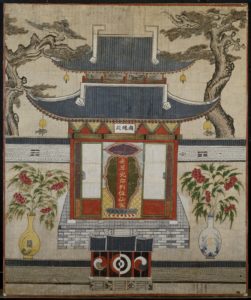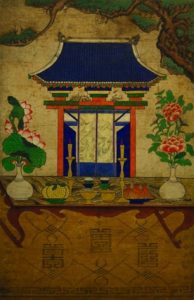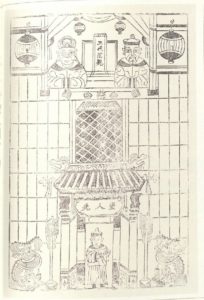Honoring the Ancestors
Although Confucianism is largely considered a social ethic rather than a religion in China and Korea, and Confucian doctrines stress rationalism and condemned irrational superstitious folk belief, its religious elements can be seen in the rituals of ancestor worship.[1] Both Chinese and Korean create shrines and make offerings to their family ancestors, as filial piety is a core value in Confucianism. At the same time, as ancestors have passed on to another world, their spirits are believed to become protectors of their bloodline.[2] However, not every family has the wealth or the space to build a separate shrine for their ancestors, so many families use paper alternatives.
- Spirit Shrine. Ink and color on paper, 171×143.8 cm. Joseon Dynasty, Korea. Brooklyn Museum.
- Spirit Shrine. Ink and color on paper, 121×80 cm. Joseon Dynasty, Korea. The British Museum.
The ancestral shrine painting in Korea is called Kam Mo Yo Je Do (감모여재도 感慕如在圖), which is a special genre in Korean folk painting. It is placed in an ordinary Korean home, where it serves the same function as a physical shrine. The painting depicts the architecture of an ancestral shrine, accompanied by auspicious symbols like pine trees for longevity, peony for prosperity, and lotus for purity. The ancestors are usually represented by the memorial tablet within the shrine, for example, in the image on the left, the tablet reads “the divine presence of late kings and queens,” referring to the male and female ancestors. The painting on the right does not follow such convention, instead, it shows a folding screen in the place of the tablet. However, during a worship ceremony, a paper slip with the name of the ancestor would be pasted in its place.[3] There are also offerings of food, drink, and candles in front of the architecture, as a replacement of real offerings, which is likely to be a later development in this genre.[4]
The paper god Zuzong (祖宗, Ancestors) from Neiqiu has a similar structure as the Korean ancestral shrine painting. It shows a structure with a front gate with stone lions and a pair of lanterns, and a shrine with memorial tablet inside, which reads “Ancestors of three generations.” Unlike the Korean painting, which only depicts the architecture and offerings, the paper god also include figures: inside the shrine, an elderly couple are sitting beside the tablet, representing the male and female ancestors of the family. This paper god is pasted on the wall of the living room or master bedroom, with an offering table in front of it. During the Spring Festival, the family would offer a part of their daily meals to the ancestors, shwoing that they too are a part of the family. [5]
[1] Zo Zayong. “Confucianism and Korean Folk Painting.” Introduction to Korean Folk Painting. Emillle Museum. 58.
[2] Feng, Jicai. Chinese Woodblock New Year Picture Collection: Neiqiu Shenma. Zhonghua Book Company. 2009: 312.
[3] “painting (감모여재도 感慕如在圖).” The British Museum. Web. Access March 12, 2020.
[4] Zo Zayong and Lee U-Fan. “Shamanistic Pictures.” Traditional Korean Painting: A Lost Art Rediscovered. Translated by John Bester. Kodansha International. 158.
[5] Feng jicai. 312.


